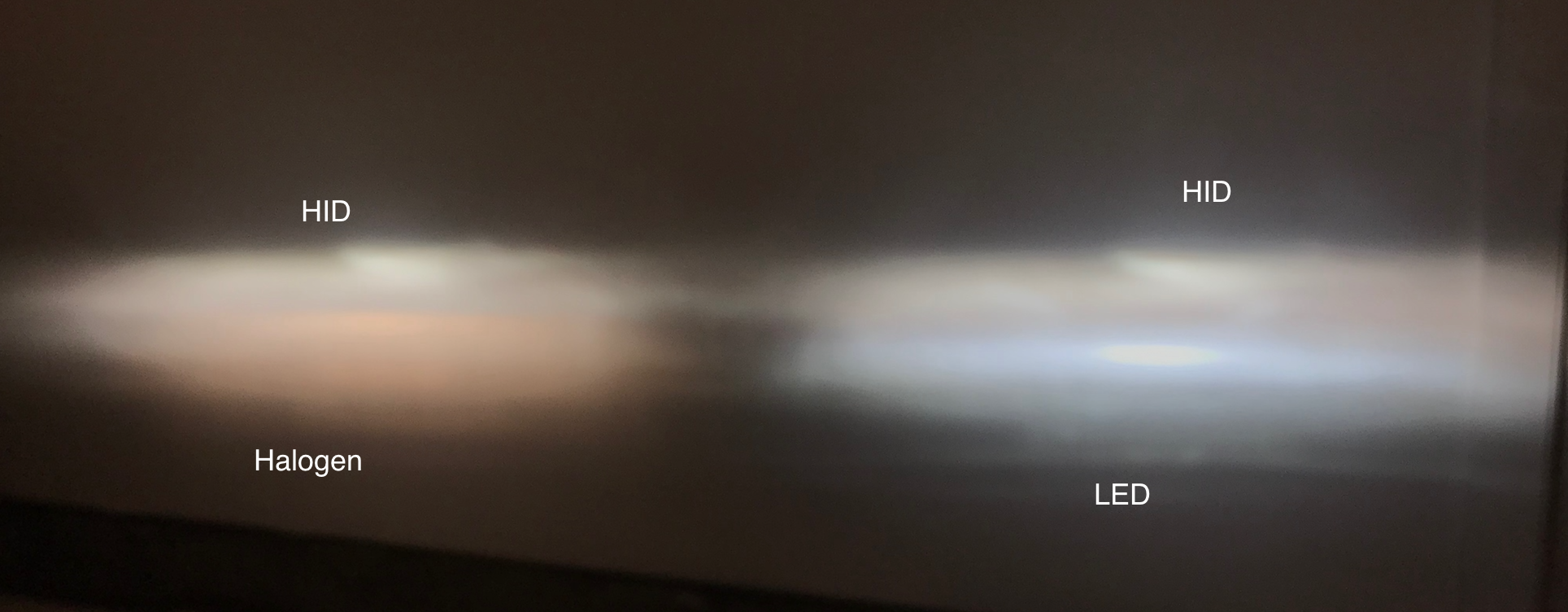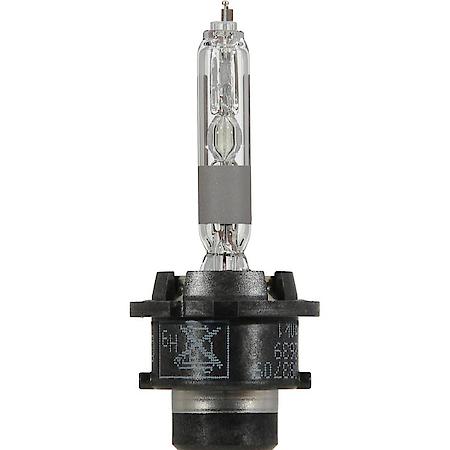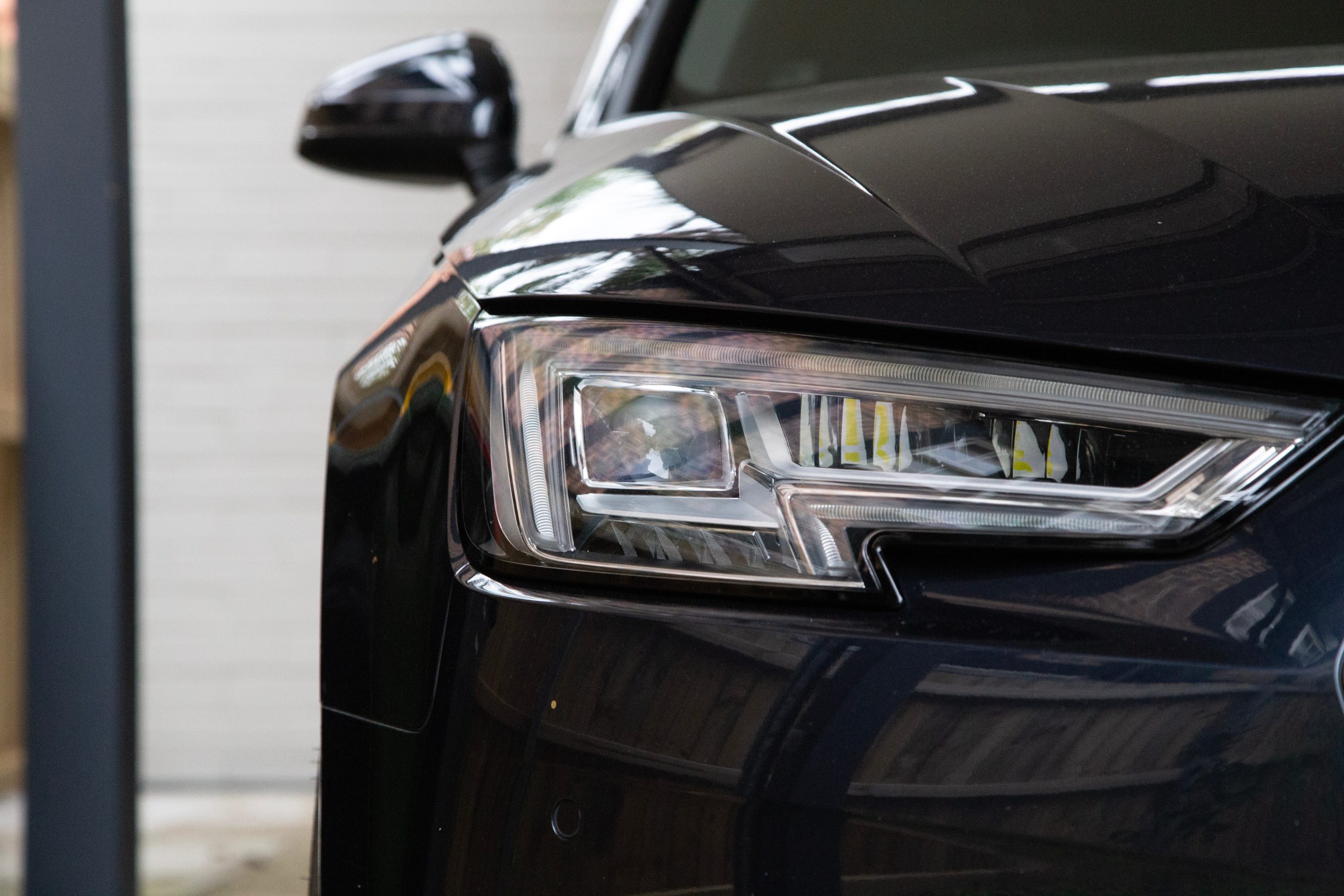HID vs. LED Headlights: And the Winner Is…
And the winner is… LED headlights.
That’s the short answer.
Currently, there are three leading technologies in the automotive headlight realm:
While halogen bulbs have been the norm since the car was invented, over the last two decades, they have been slowly replaced by HID bulbs and, more recently, LED bulbs.
In recent years, HIDs and halogens have been favored among manufacturers (in comparison to LEDs). But with current improvements in LED technology, LED headlights are becoming the new standard for headlights.
HID vs. LED vs. Halogen Headlight Bulb Light Output Comparison:

The image above demonstrates a clear advantage of LED headlight bulbs. This example uses the headlights of an Infiniti G35. From the factory, it’s equipped with HID low beams and halogen high beams. In this case, I’ve swapped one of the halogen bulbs for a LED bulb.
The Light intensity is quite weak for the halogen and HID, while the LED bulbs have a very tightly concentrated, focused beam right near the center, with a strongly curved beam emanating from the center.
Also, the color is higher on the Kelvin scale, coming in the right around a 6000K color, while the HIDs are closer to 5000K, and the Halogens at a 3500K or so. Headlights whose light output most closely matches the sun’s color temperature tend to be the most effective for the human eye. The sun’s color temperature at noon is 5500K – 6000K.
LED Advantages Over HIDs
LED headlights win the comparison against HIDs narrowly for a few reasons:
- Longevity: LED headlights have unmatched longevity compared with HID and especially halogen headlights.
- Light Output: LED and HID headlights both have excellent light output, but LEDs illuminate instantly, while HIDs take a few seconds to achieve full brightness and proper color.
What are LEDs?

LED stands for light-emitting diode. Unlike halogen bulbs, LEDs don’t have a filament that current is passed through. Instead, an LED transfers current through a semi-conductor. This movement of electrons generates light. If you really want to get into the details of this, check out How Stuff Works article on the topic. One advantage of this form of light generation is that by adjusting the material properties of the semi-conductor, one can adjust the frequency of the emitted light, thus changing its color.
LEDs have been in use for decades. You’ll see them on your cellphone and laptop, even ones that are 20 years old. Their small nature and low power consumption make them perfect for such applications. Additionally, in low current applications, they also generate minimal heat.
Lexus was the first manufacturer to include LEDs in their headlights in 2006, but it wasn’t a complete implementation. In 2007 Audi revealed full-LED headlights in the V10 model of their R8 sports car.
Because LEDs can be manufactured in various sizes, several nifty applications have been developed with them. Audi,, for instance,, had a headlight on the 2013 A8 that had 25 individual LEDs per headlight. This system allowed them to dim certain sections of the light while allowing the rest to remain bright. What this entails is that the road directly in front of the car can remain brightly lit, whereas areas occupied by oncoming traffic have only a dim light shining at them. This results in an overall safer environment for night driving for all road users.
The aftermarket LED scene has two sections at the moment. The biggest is the replacement LED kit option. This comprises LED bulbs that are shaped to be drop-in replacements for conventional halogen bulbs.
The alternative is purchasing an entirely new headlight fixture. This is significantly more expensive, and the LED kit option is thus much more popular. It also requires the least modifications to your car. Both options require additional electronics between the car and the light. This is often referred to as the driver. The main reason for this is that LEDs operate at a lower voltage than the conventional 12V that a car provides. This can confuse the computer systems within cars, so the extra electronics are used to increase the voltage drop and avoid errors.
Contrary to popular opinion, LEDs do generate heat. Less than a halogen, but because LEDs are so small, this heat is concentrated in one spot. As a result, high-power LEDs require cooling mechanisms to ensure they don’t overheat. In some instances, this can be a simple heatsink, but more often, a fan is also included to ensure the flow of cool air over the heatsink. Heatsinks are usually located at the back of the bulbs and can extend up to an inch. This is a potential cause of fitment issues and something one should check before purchasing a kit.
The lifetime of an LED light is most closely linked to its operating temperature. The cooler the operating temperature, the longer it will continue to function. Most manufacturers promise that, with proper care, their LEDs will survive the lifetime of the vehicle they’re fitted to.
What are HIDs?

HID stands for High-Intensity Discharge. It is often referred to as a xenon light, referencing the gas that the bulb contains. It differs from both halogen and LEDs in that the source of its light is an electric arc that takes place between two tungsten electrodes.
We most often see HID lamps used in the lighting of large areas, such as street lamps and flood lamps in stadiums. They provide a whiter light and are twice as efficient as halogen lights. This is a factor that is very important for locations where constant high-power lighting is required.
In a similar fashion to LEDs, HID headlights offer brighter light than halogens at a higher level of efficiency. This is the main reason for their use in headlights. HIDs were first used in cars in the early 90s, with a variety of manufacturers testing them out. The lights are also famed for their characteristic blue tinge, giving them a unique ‘cool’ look and popularizing them with auto enthusiasts.
They can be purchased as full replacement headlamp units or as plug-in kits. In the same manner that an LED kit requires additional electronics, HIDs require a ballast. The ballast has several functions. Firstly, it creates a high voltage pulse to initiate the arc. It then monitors and controls the current flow to the bulb for regular operation. This is most often in the form of AC power in contrast to the car’s DC supply. The ballast takes the form of a small sealed unit the size of a cigarette box.
The lifetime of an HID light is most closely linked to the number of times the light is turned on and not the total running time of the light. However, under normal circumstances, this should warrant 2500 hours of use. What the manufacturers claim is three times more than a standard halogen light bulb.
HID vs. LED: The Pros and Cons
HIDs are the more mature technology at the moment. They’ve been around for over two decades and are well understood. LEDs are newer to the scene but are overtaking HIDs in popularity and technology.
From a brightness perspective, LEDs are king. HIDs do very well, and some can achieve LED levels of illumination, but in a standard comparison, the LED will win. Whether it’s to the degree that you would care about could be argued, but from an objective point of view, they are the brightest.
On the color spectrum, HIDs offer a wider selection, everything from 3,000K to 30,000K and then some. LEDs are more limited, with an available range from 3,000K to 10,000K. Regardless of what’s available, most people will choose a color in the 4,000K to 6,000K range. These are the colors that best mimic daylight and offer the best night-time driving results.
Due to the nature of HIDs, they have a brief warmup period, in the order of 5 seconds. During this time, you don’t have the brightest light. LEDs, on the other hand, have an instant-on ability, so you go immediately from darkness to full brightness. Not a major issue as lights are conventionally turned on while the car is stationary.
HIDs produce light in the infra-red (IR) spectrum along with visible light. This is beneficial for people in colder climates as it assists in melting snow and ice, which may otherwise block up headlights. LEDs do not emit IR light. Manufacturers have tried to replicate the function by blowing hot air onto the headlamp lens. Retrofits don’t achieve this, but if you live in a moderate climate, then it won’t be a problem anyway.
HID and LED kits are available at a range of prices. When comparing products with similar performance characteristics, HID kits can be up to half the price of LED kits. This is mainly because LEDs are still the new kid on the block. This is set to change. The counter-argument from LED proponents is the lifetime of the products. Where LED kits have promises of 30,000 hours and up, HID kits are more in the order of 2,500 hours.
When retrofitting components into your car, you need to pay close attention to certain regulations. If you purchase an entire headlamp unit with either LED or HID lamps, you won’t have a problem. That’s because the housing is designed around a specific LED or HID lamp. If you purchase just a kit featuring plug ‘n play lamps, you’re deviating from the original design of the housing.
As such, it creates a risk that components may not fit properly. This may result in a spread of light which is hazardous to other drivers. Whenever possible, consult local law enforcement, or your product supplier, to ensure that the lighting you choose meets the necessary requirements.
LED & HID are Both Superior to Halogen Headlights
Currently, everyone accepts that HID and LED bulbs are far superior to halogens. Unfortunately, due to a large price disparity, manufacturers are still installing halogen bulbs in the majority of new cars. As such, HID and LED technology for headlights is only available on more expensive vehicles or as an extra.
Fortunately, there is a healthy aftermarket scene to support the desires of those wanting newer technology in their older vehicles. And so, for the purposes of this article, we’re going to ignore our old friend the halogen and just focus on HID and LED technology.
LED Product Recommendation
If you’re looking for a good LED kit to pop into your car, the Opt7 LED kit is a great place to start. It’s not cheap, but not many LED kits are. For $100 you’re getting a set of LED bulbs with matching drivers, along with Opt7’s over 20 years of experience in the lighting industry.
The kit is designed for a quick installation, and all the wiring is already done. This means all you have to do is remove your old bulbs and plug these new ones in. The bulbs make use of the brand new Cree LEDs, currently the brightest on the market, and rated a cool-white color (6,000K).
Opt7 LED kit with heatsink enclosed fan visible on the base
The lamps have a prominent heatsink mounted to their bases, with forced cooling thanks to a dual-speed fan. All the components are IP67 weather resistant rated and come with a 2-year warranty supported by their California-based headquarters.
This is a quality piece of equipment, sure to last the lifetime of your vehicle and be an improvement on even the best halogen light installation. Opt7 offer this product in a variety of form factors, with one of them certain to fit your headlight enclosure.
HID Product Recommendation
If you’d rather opt for an HID kit, the current best-selling product is Kensun’s HID kit. Not only available in a range of forms, you can also pick from a selection of 12 different color temperatures. HID kits can be had for as low as $30, with the Kensun kit coming in at a reasonable $60. If you want to spend more, that is also very much an option.
The kit comes in a small aluminum carry case and includes two light bulbs and two ballasts. They also supply some clips to assist with mounting the ballasts. The lights all come pre-wired, so it should make for an easy installation.
The kit is covered by a 2-year warranty and promises a lifetime of 10 times that of ordinary halogen bulbs. If you’re looking to make the jump to HID, this is a safe bet. Kensun has established itself with a solid reputation for quality products and good customer service.
Conclusion: LEDs are Superior to HIDs
If you’re trying to decide between a LED or HID conversion kit for your vehicle, we suggest going with LEDs. New developments in LED technology have made them both affordable and superior sources of light for your vehicle.
However, not all aftermarket led conversion kits are created equal. Do your research and choose the best-LED headlights that most closely place the light source inside the headlight housing to that of the factory bulbs. This will make all the difference in how well your new headlights perform.




